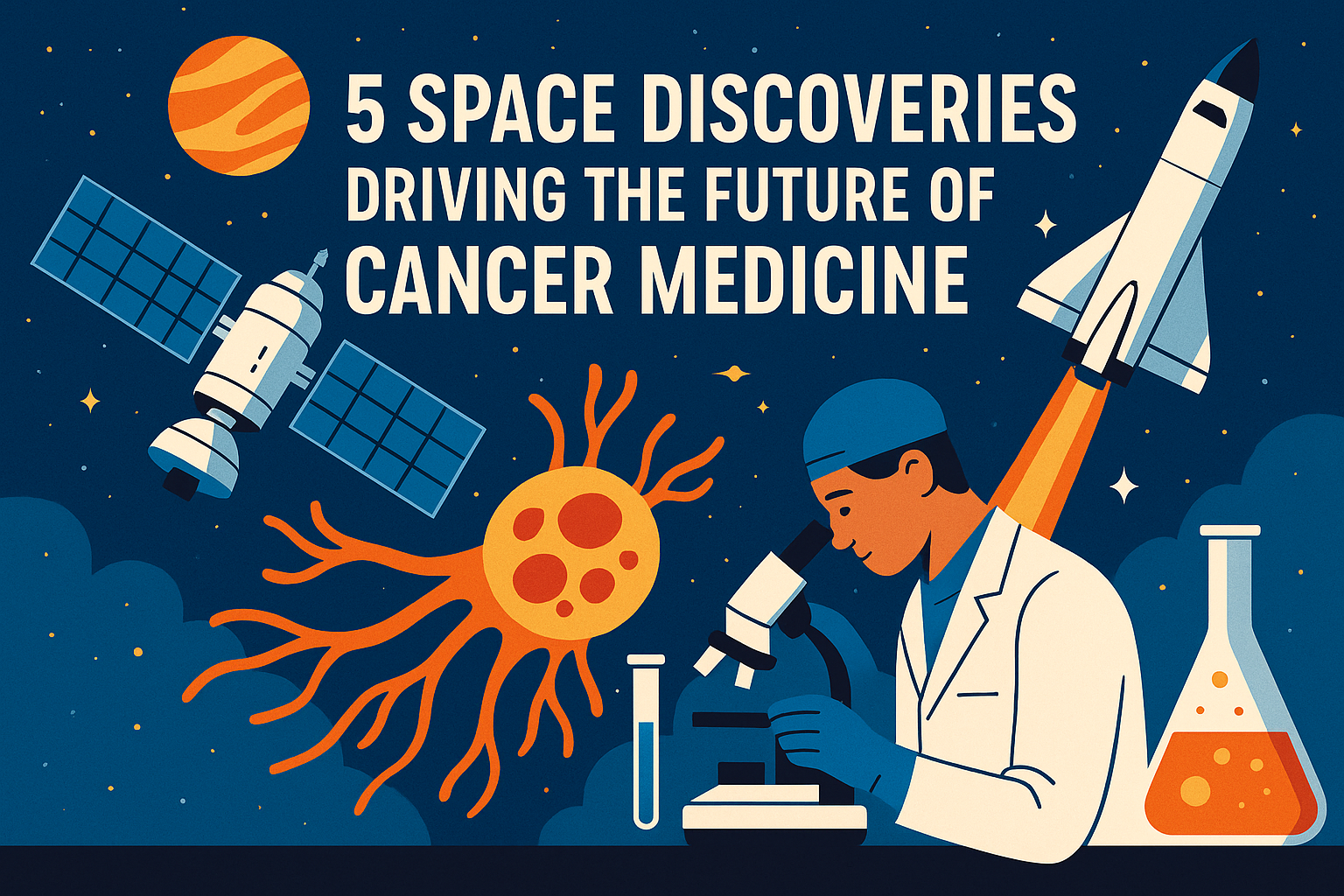The global space economy is no longer just about satellites, rockets, or astronaut missions. Today, space is opening a new frontier in medicine—especially in the development of breakthrough cancer treatments. With projections estimating the space economy to touch $1.8 trillion within the next decade, opportunities are expanding far beyond tourism or farming experiments in orbit. One of the most exciting developments is the use of space’s unique environment to build pharmaceutical factories in orbit, where next-generation drugs can be designed and tested.
In this article, we will explore 5 Ways Space Research Powers Next-Gen Cancer, showing how microgravity and other cosmic conditions may revolutionize oncology, bring life-saving treatments to patients, and reshape the pharmaceutical industry forever.
1. Microgravity Enhances Drug Development
One of the 5 Ways Space Research Powers Next-Gen Cancer is by enabling scientists to test how cancer cells and drugs interact in microgravity. On Earth, gravity constantly influences how cells grow, divide, and respond to external stimuli. In space, however, the absence of gravitational pull provides a unique laboratory where cancer cells often behave more aggressively.
By studying cancer in microgravity, researchers can observe:
- Faster tumor cell growth patterns
- Changes in how cancer spreads (metastasis)
- Altered drug absorption and cell resistance
This accelerated process allows scientists to test new cancer drugs more quickly, helping them identify which treatments may be most effective. Essentially, space provides a fast-forward button for drug development.
2. Protein Crystallization for Precision Medicines
Another critical way in which 5 Ways Space Research Powers Next-Gen Cancer is through protein crystallization experiments. Cancer drugs often target specific proteins that drive tumor growth. To design precision treatments, researchers need to study the exact 3D structure of these proteins.
On Earth, crystallizing proteins is a slow and imperfect process because gravity interferes, often leading to flawed results. In contrast, the zero-gravity conditions of space allow proteins to form larger, more perfect crystals, giving scientists clearer images at the molecular level.
With these insights, pharmaceutical companies can design cancer drugs that:
- Target tumors more precisely
- Reduce side effects
- Improve treatment outcomes
This approach could lead to next-gen cancer medicines that are highly personalized and far more effective than current therapies.
3. Biomanufacturing in Space Factories
Startups are now racing to build orbital factories that specialize in drug manufacturing. One London-based company is pioneering this effort, aiming to set up a pharmaceutical lab in space. This is one of the most promising examples in our discussion of 5 Ways Space Research Powers Next-Gen Cancer.
Why manufacture in space? Because certain biological processes work better in microgravity, including:
- Growing organoids (mini human organs) for cancer research
- Producing advanced biomaterials for drug delivery
- Creating novel compounds that cannot be synthesized on Earth
Such innovations could revolutionize the pharmaceutical supply chain. Within a decade, patients may receive cancer drugs literally made in space, offering hope where conventional medicine has failed.
4. Faster Clinical Testing and Breakthrough Discoveries
Another way 5 Ways Space Research Powers Next-Gen Cancer is transforming healthcare is through accelerated clinical trials. In space, cancer cells grow and mutate more rapidly, which allows scientists to simulate years of cancer evolution in weeks. This means potential treatments can be evaluated faster.
Moreover, astronauts themselves provide valuable biological data. Their immune systems weaken in space, mimicking certain cancer-like conditions. Studying astronauts helps scientists understand how the human body responds to extreme stress, radiation, and treatment—all of which are relevant to oncology.
Faster testing means:
- Shorter timelines for drug approval
- Lower R&D costs
- Faster access to next-gen treatments for patients
This speed factor alone could save countless lives.
5. Collaboration Between Space and Pharma Sectors
The final and perhaps most important of the 5 Ways Space Research Powers Next-Gen Cancer is the collaboration between the space industry and pharmaceutical companies. With billions of dollars being invested into the space economy, governments, startups, and major corporations are forming partnerships to unlock the health benefits of space research.
For example:
- SpaceX and other private launch companies are enabling cost-effective drug experiments in orbit.
- NASA and ESA are supporting biotech startups focused on cancer research.
- Pharmaceutical giants are entering joint ventures to scale up space-driven discoveries.
This collaboration ensures that insights from space are not just scientific experiments but become practical treatments available to patients worldwide.
The Promise of a Space-Driven Medical Future
The phrase 5 Ways Space Research Powers Next-Gen Cancer is not just a catchy headline—it reflects a genuine transformation in how humanity will fight one of its deadliest diseases. With the space economy booming, cancer research in orbit has the potential to:
- Deliver more effective and personalized treatments
- Speed up the discovery of new medicines
- Lower costs in the long run
- Provide hope to millions of patients
Imagine a future where a patient in London, New York, or Mumbai receives a cancer drug developed in zero gravity. What once sounded like science fiction is quickly becoming science fact.
Conclusion
As the race toward a $1.8 trillion space economy accelerates, the medical field stands as one of its greatest beneficiaries. By focusing on 5 Ways Space Research Powers Next-Gen Cancer, we can clearly see how space science is pushing the boundaries of what’s possible in oncology. From microgravity experiments and protein crystallization to space-based manufacturing and global collaborations, the future of cancer treatment may quite literally be written among the stars.
The promise is clear: space is not just humanity’s next frontier for exploration—it’s also the next frontier for healing.
